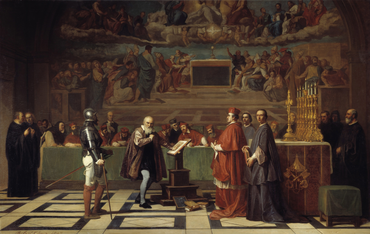
Back Inkwisisie Afrikaans Inquisition ALS Inquisición AN محاكم التفتيش Arabic محاكم التفتيش ARZ Inquisición AST İnkvizisiya Azerbaijani Инквизиция Bashkir Inquisition BAR Святая інквізіцыя Byelorussian

The Inquisition was a Catholic judicial procedure where the ecclesiastical judges could initiate, investigate and try cases in their jurisdiction. Popularly it became the name for various medieval and reformation-era State-organized tribunals whose aim was to combat heresy, apostasy, blasphemy, witchcraft, and other dangers, using this procedure. Studies of the records have found that the overwhelming majority of sentences consisted of penances, but convictions of unrepentant heresy were handed over to the secular courts for the application of local law, which generally resulted in execution or life imprisonment.[1][2][3] If the accused was known to be lying from other credible evidence, a single short application of non-maiming, unbloody torture was allowed, to corroborate that evidence.[4][5]
Inquisitions with the aim of combatting religious sedition (e.g. apostasy or heresy) had their start in the 12th-century Kingdom of France, particularly among the Cathars and the Waldensians. The inquisitorial courts from this time until the mid-15th century are together known as the Medieval Inquisition. Other banned groups investigated by medieval inquisitions, which primarily took place in France and Italy, include the Spiritual Franciscans, the Hussites, and the Beguines. Beginning in the 1250s, inquisitors were generally chosen from members of the Dominican Order, replacing the earlier practice of using local clergy as judges.[6]
Inquisitions also expanded to other European countries,[3] resulting in the Spanish Inquisition and the Portuguese Inquisition. The Spanish and Portuguese inquisitions often focused on the New Christians or Conversos (the former Jews who converted to Christianity to avoid antisemitic regulations and persecution), the Marranos (people who were forced to abandon Judaism against their will by violence and threats of expulsion) and on Muslim converts to Catholicism, as a result of suspicions that they had secretly reverted to their previous religions, as well as the fear of possible rebellions and armed uprisings, as had occurred in previous times. Spain and Portugal also operated inquisitorial courts not only in Europe, but also throughout their empires: the Goa Inquisition, the Peruvian Inquisition, and the Mexican Inquisition, among others.[7] Inquisitions conducted in the Papal States were known as the Roman Inquisition.
The scope of the inquisitions grew significantly in response to the Protestant Reformation and the Catholic Counter-Reformation. In 1542, a putative governing institution, the Supreme Sacred Congregation of the Roman and Universal Inquisition was created. With the exception of the Papal States, ecclessiastical inquisition courts were abolished in the early 19th century, after the Napoleonic Wars in Europe and the Spanish American wars of independence in the Americas. The papal institution survived as part of the Roman Curia, although it underwent a series of name and focus changes, now part of the Dicastry for the Doctrine of the Faith.
The opening of Spanish and Roman archives over the last 50 years has caused historians to substantially revise their understanding of the Inquisition, some to the extent of characterizing previous views as "a body of legends and myths".[8] Many famous instruments of torture are now considered fakes and propaganda.
- ^ "Internet History Sourcebooks Project". legacy.fordham.edu. Archived from the original on 20 March 2016. Retrieved 13 October 2017.
- ^ Peters, Edwards. "Inquisition", p. 67.
- ^ a b Lea (1887a), Chapter VII. The Inquisition Founded.
- ^ Bishop, Jordan (24 April 2006). "Aquinas on Torture". New Blackfriars. 87 (1009): 229–237. doi:10.1111/j.0028-4289.2006.00142.x. ISSN 0028-4289.
- ^ Lempinen, Edward (20 July 2022). "The tortures of the Spanish Inquisition hold dark lessons for our time". Berkeley News.
- ^ Peters, Edward. "Inquisition", p. 54.
- ^ Murphy, Cullen (2012). God's Jury. New York: Mariner Books – Houghton, Mifflin, Harcourt. p. 150.
- ^ Iarocci, Michael P. (1 March 2006). Properties of Modernity. Vanderbilt University Press. p. 218. ISBN 0-8265-1522-3.